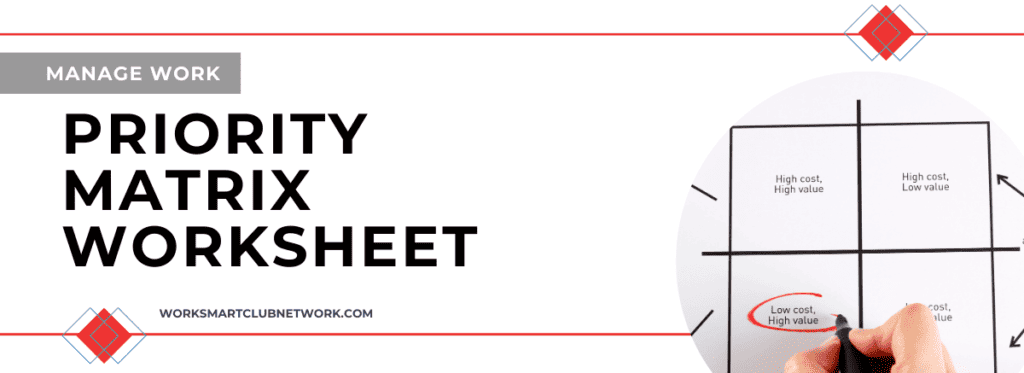
Priority Matrix Worksheet
Time is a finite resource. Never before has it been so important to manage your time. There is so much competing for our attention, making it easy to get sidetracked.
This exercise will help you identify your priorities. This grid represents the four categories of activity.
Download the worksheet and follow the instructions. The worksheet takes you through an exercise to evaluate your daily activities. This is very helpful and will highlight activities that may be complete time wasters or energy drains. These are the activities that keep people from their most important jobs.
Start By Defining Your Tasks:
Important can be defined as an activity that moves you toward your desired outcomes, personally or professionally. The consequences of not following through are not felt immediately and may take time to show up. Ignoring these activities significantly impacts and is often the difference between success and failure.
Urgent usually carries with it a need for immediate attention and is usually someone else’s agenda. The consequences of not following through can be quick.
Many people confuse this with “important” because of the immediate consequence. It takes up a lot of resources like time and energy, steals from the future, and drains away creativity.
We will talk about each Quadrant individually. Quadrant two is highlighted in blue and is at the heart of effective time management and leadership.
Quadrant 1: Important And Urgent
These activities consist of deadlines, problems, and crises that significantly impact and demand immediate attention. This includes situations you could not have foreseen, like health issues and inevitable crises in your industry, along with activities you did not plan for and “surprise” you.
For example, you “knew” about an inspection and missed the deadlines on your calendar because you were too busy putting out fires, and you ended up surprised when they showed up.
Because this quadrant carries high emotional energy, you lose perspective if you live here most of the time. This is when you might escape into Quadrant 4, Not important and not urgent activities, to slow down your racing thoughts or high emotions.
Tip: Leave time in your day to accommodate a crisis.
Quadrant 2: Important. Not Urgent.
This is where you want to spend most of your time. The more time you spend here, the less time you spend in Quadrants 1 or 4.
With planning, many deadlines and crises can be eliminated. By spending time here, you will eliminate the procrastination that happens with the flight-or-fight reaction and the perpetual crisis mode of thinking prevalent when stressed.
Tip: Schedule time every day to plan, think, and review. This is especially true when you feel busy.
Quadrant 3: Urgent. Not Important.
This is where many people spin their wheels. Because of the “urgency,” activities can be mistaken for ‘important’. Remember what we have said about distraction and the false sense of urgency created when focus is lost.
This category of activities begs the question, “Can this be delegated or scheduled for a later date?”
These tasks usually come from someone else’s agenda and include returning specific phone calls, most emails, texts, and requests from staff and family members. These activities can be planned for and then will carry the priority based on your daily calendar.
Tips:
- Plan for those staff requests to talk about issues.
- One or two individuals usually seem to want more of your time. Plan for this and meet regularly with them; learn to set boundaries when they approach you and schedule their requests so you stay in charge of how you spend your time/energy.
- Learn to delegate and follow up.
- Make it a goal to reduce the time you spend in this quadrant and give this time to Quadrant 2.
Quadrant 4: Not Urgent. Not Important.
This quadrant is where people end up wasting time. It could be because they do not know what is important or because of distraction. This is not the category for unwinding that is Quadrant 2.
Mindless activity, goofing off, engaging in gossip, searching the Internet, and scrolling through social media under the guise of research waste the organization’s time and squander your career capital because they drain confidence and energy. People are energized when they are productive.
Tip:
- Schedule self-care activities to unwind.
- When you schedule downtime, you will not have to “steal” it and waste more than is needed to recharge.
- Do an audit of your priorities and how you spend your time. Be honest.
- Learning to make these distinctions and plan your time will dramatically reduce the energy drain you feel from the false state of urgency.
Organize Your Tasks Worksheet
Once you have prioritized your tasks and have them in their categories, it is time to schedule. You know how much time you have left for other activities by time-blocking your essential and nonnegotiable activities. Use this worksheet to see how this works.

